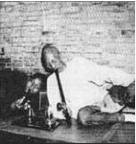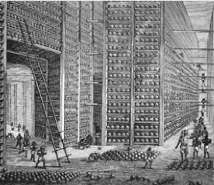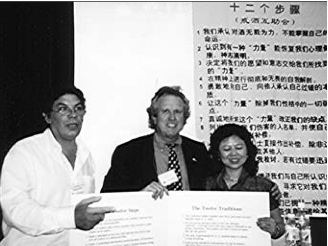First Appeared in CSAM NEWS - Winter 2004
Addiction Medicine in China
By David Smith, MD
In September 2002, I went to
China as part of an international
delegation to the World Health
Organization/Beijing University
conference on substance abuse held
at the Beijing Institute of Mental
Health. I had the privilege of meeting
the leading mental health and addiction
doctors in China, including
Professor Shen Yucun and to be part
of a historic public health moment
that introduced the concepts of twelvestep
recovery to one quarter of the
world's people.
Beijing University and the Beijing
Institute of Mental Health are the primary
institutions for the delivery of
mental health services in China. The
mental health hospital was founded in
1951. Professor Wu Zhengya, a psychiatrist
famous throughout China,
established a department of psychiatry
for teaching and research.
Professor Shen Yucun assumed a
leadership role and was influential in
bringing about modern addiction treatment
and the fellowship of Alcoholics
Anonymous to China. The conference
was organized by Dr. David Powell,
Director of the Asia Institute. He has
long worked with China in the area of
substance abuse and AIDS prevention.
I was privileged to be part of a faculty
that included experts from around
the world, including Dr. George Valliant,
who has made such a contribution to
the addiction medicine field with his
research on the national history of
alcoholism, including the crucial role of
AA and long term recovery from alcoholism,
and as leadership from
Narcotics Anonymous International, and
Dr. Wayne Moran, a leading addiction
medicine expert in Hong Kong and fellow
International Doctors in AA and
International Society of Addiction
Medicine member. Our delegation also
included representatives of Narcotics
Anonymous General Services
Administration and Alcoholics
Anonymous General Services Administration.
Dr. Moran indicated that while non-Chinese expatriates
living in China had AA meetings, until two years ago,
AA meetings for Chinese Nationals was illegal. Despite
an escalating heroin problem in China, there were no
Narcotics Anonymous meetings, and because of frequent
needle sharing there is a dramatic escalation of
HIV/AIDS.
In August 2001, Dr. Valliant and two members of AA
General Services Administration were invited to the
People's Republic of China to talk about alcoholism and
AA. It was the first time members of the AA fellowship
were able to share their experience, strength, and hope
with the medical establishment in China and with the
Pioneers of AA in China. The Pioneers of AA in China,
who held the first meeting less than a year and a half
prior to this meeting, met with the delegation from the
United States to strengthen the acceptance of AA in
China by explaining the 12-step process of recovery from
an Addiction Medicine perspective.
My presentation focused on addiction as a brain disease
and various techniques for detoxification and treatment
of dependence on opiates, stimulants including
amphetamine, cocaine, and alcohol, using techniques
developed at the Haight Ashbury Free Clinics and principles
of addiction treatment established by the American
Society of Addiction Medicine.
Opium and Heroin in China
Opium and heroin have a long history in China. Many
Chinese have bitter recollections of the opium wars of
the 19th Century, when British traders backed by English
government gunboats forced opium grown in British
India into China and thereby virtually ruining the Chinese
economy.
The First Opium War started when the Chinese government
tried to stop British merchants from illegally
importing opium. Britain responded by sending an expedition
of warships to the city of Guangzhou. The British
won a quick victory, and the conflict was ended by
treaties under which China was forced to pay a large
indemnity, open five ports to British trade and residence
including the establishment of British Hong Kong as a
lucrative port for the importation of heroin. The British
also won the Second Opium War, fought for much the
same reasons. The resulting treaty opened additional
trading ports and allowed even greater privileges to
Western countries. Dr. Moran described the creation of
Hong Kong in the 1890s as "a drug deal gone bad" for
China.
Today, Hong Kong still serves as the major drug
smuggling port, not only into China, but worldwide.
In 1949, when China's communist government took
power, there were 70 million opium addicts. The communists
shut down the opium dens and declared the nation
drug free, claiming that heroin addiction was a consequence
of the capitalist system. Because of draconian
measures and capital punishment of drug abusers, heroin
addiction rates decreased dramatically. In 1988 it
was estimated that there were less than 70,000 heroin
addicts in all of China.
As a result of China's policy of rapid industrialization,
with its opening of borders to free trade, there has been
a dramatic increase in heroin addiction. Official estimates
presented at our conference estimated the current
number of heroin addicts in China at 900,000.
Non-government epidemiological experts indicate that the
actual number is much higher ranging from four million to
ten million. This underestimation of the extent of addiction
is largely due to the government's draconian
approach. In China, drug traffickers are often executed
and addicts are sent to labor camps - a similar approach
to the US criminal justice system of boot camps and
incarceration.
In his presentation, Dr. Moran painted a graphic picture
of the victims of the potent heroin available, including
needle abscesses and overdose deaths. Many
overdose deaths occur after addicts are released from
the labor camps and had lost their tolerance for heroin.
They readministered the drug, overdosed and died. The
success rate for heroin addicts when released from the
labor/political rehabilitation camps was less than five
percent according to the government, similar to the
Lexington incarceration experience of the United States
in the 1950s where only about 5% of the addicts stayed
off heroin after their discharge.
As a result of the Chinese government's failure to
control addiction, experts in our delegation were invited
to present contemporary addiction treatment standards
based on ASAM patient placement criteria ranging from
antagonist therapy with naltrexone to agonist therapy
with methadone as well as drug-free therapies including
therapeutic communities. The Chinese government
opposed agonist therapy such as methadone maintenance,
but was more oriented toward antagonist therapy
such as naltrexone. Based on the trainings given by
Walter Ling, they were open to partial agonist therapy
such as buprenorphine. US drug policy with its emphasis
on supply side reduction, incarceration and just say
"no" prevention message was presented by Charles
Curie director of SAMHSA and Barbara Rogers of the
Office of National Drug Control Policy.
Alcohol in China
Alcohol, first introduced 4,000 to 5,000 years ago, has a
much longer history in China than opium and heroin.
Chinese nobility consumed alcoholic beverages in the
form of rice wine at social events and national ceremonies.
Alcohol was romanticized and Chinese literature
considered appropriate drinking a virtue to beautify, dignify,
and philosophize. Despite this romanticization early
Chinese medical literature recognized the potential for
alcohol problems.
Chinese experts presented medical literature on
alcohol problems including mentions of fetal alcohol syndrome
symptoms in ancient medical textbooks. They
used the following quote, "Intercourse after drinking will
make your offspring inferior."
However, Chinese medical textbooks emphasize the
health benefits of alcohol but contain very little on alcoholism.
Since the 1980's, China has rapidly moved from
a rural agricultural society to an industrialized, urban
one. The attendant disruption of family has greatly
increased the problem of alcoholism, particularly among
males.
I had the privilege of attending a Chinese AA meeting
and participating in medical grand rounds with Dr. Moran.
Members of our delegation interviewed patients on the
alcohol ward at the psychiatric facility and discussed
cases with residents. Most of the alcoholic patients
that entered the psychiatric facility came in because of
alcoholic hallucinations and DT's. So their alcoholism
had to be very far advanced with severe medical and psychiatric
symptomatology before they were initiated into
treatment.
Alcoholics Anonymous had gained a foothold of very
little to what we would call post-hospitalization aftercare
in China. Although the meeting was run in a fashion very
similar to the US meetings, it was interesting that the
psychiatrist that translated indicated that in China they
do not believe in God and therefore use higher power in
the third step. There are several different definitions for
higher power and it appears that the spirituality of AA is
much more applicable to current Chinese philosophy and
society than a Western-style religion would be. The focus
of AA and its traditions allowed AA to gain a foothold and
help suffering alcoholics in China. A more traditional religious
approach would have been rejected.
Tobacco and Other Drugs
Tobacco addiction was an enormous problem in China
and had a long history. It was first introduced during the
Qing dynasty in the middle part of the 19th Century. As
previously discussed, this was a period of increasing
Western influence and trade, which led to the Opium War
and the Boxer Rebellion (1898-1900). The Qing dynasty,
China's last, was overthrown by nationalist revolutionaries.
Initially, tobacco use was strictly prohibited by the
emperor, but it became the number one recreational drug
until the introduction of opium. It was estimated that
35% of the population smoked. Today tobacco is a leading
cause of medical death and disability.
There was also the recent introduction amongst the
youth of a variety of drugs that have been long seen in
the United States. In China, ice (d-methamphetamine) is
beginning to make its appearance in clubs, especially in
prosperous coastal cities, such as Shanghai, just as it
did in the US during in the 1990's. Methamphetamine,
manufactured mainly in illicit laboratories, has been
increasing dramatically both in China and other areas of
Asia such as Thailand. (Walter Ling has been organizing
modern drug treatment at the request of the Thai
Government.) Parallel to the increase in methamphetamine
has been a dramatic increase in violence.
The Chinese call the drug ecstasy "Yaotouwan" or
"headshaking pills." The concept of the rave club was
first described in China in 2000, indicating that drugs,
sex, and rock and roll have started to permeate China in
the new millennium, particularly in more Westernized
cities such as Shanghai, which interestingly enough was
where Mao Tse Tung organized the first Chinese
Communist Party meetings in the 1920's.
In the US, psychedelic rock concerts during the
1967 summer of love in San Francisco popularized the
sound of Jerry Garcia, Grateful Dead, Janis Joplin, Big
Brother and the Holding Company, Grace Slick and the
Jefferson Airplane. All eventually did benefits for the
Haight Ashbury Free Clinics. The Chinese government
frowns upon these rave clubs and individuals that are
caught using ecstasy. Even though they would not have
what we would describe as an addiction problem, they
are sent to the labor rehabilitation camps. Clearly, there
is no concept of Rock Medicine in China.
Parallel to the rise in addiction and new sexual freedom
there is a dramatic increase in sexually transmitted
diseases. Over a million people are infected by HIV in
China. Seventy percent of the new cases are IV drug
users using contaminated needles. However, the Chinese
government is ambivalent about both the rising HIV and
drug epidemic. The medical community in Beijing wants
to initiate Western-style addiction treatment and public
health AIDS approaches. Dr. David Powell who organized
our substance abuse delegation also met with the leading
HIV public health experts in China to improve their
approaches to HIV prevention and treatment.
However, on August 24, two weeks prior to our
arrival, a public health expert in Beijing, Wan Ayanhai,
was arrested and detained by the government for
attempting to protest government AIDS policy using
methods similar to Act-Up, a public advocacy citizen
group that demonstrated in favor of improved HIV/AIDS
care as in the United States. It became clear that while
some public health approaches could be accepted,
Western-style protest will not be.
I was reminded of the traditions of Alcoholics
Anonymous of maintaining focus on our purpose, which
was to help the suffering alcoholics and addicts in China.
I was privileged to be part of this historic delegation and
found the Chinese people to be informed and very friendly
hosts. Surprisingly, they were also very computer literate.
I found at the University they had accessed our
Haight Ashbury Clinic website as well as our online medical
service, AlcoholMD.com, and were quite familiar with
our work at the Haight Ashbury Free Clinics, including our
book Clinicians Guide to Substance Abuse and Dr. Daryl
Inaba's book, Uppers Downers and All Arounders.
In this age of the internet, I was able to find a computer
and communicate with my family, friends, and colleges
in the United States on a daily basis, but I couldn't
figure out the phone system or how to get around Beijing
on a bike without having a frightening experience in the
unbelievable traffic. It was easier for me to communicate
with the United States using e-mail than it was to talk on
the phone to someone down the block. Despite these
personal limitations and dependence on technology we
were able to contribute to our mission and pass along
our passion for science including epidemiology, detoxification
and treatment, including changes in neurochemistry
in association with addiction while maintaining a
compassion for people including recovery and spirituality
associated with AA and NA. Given the globalization of
information the advances in China have been dramatic.
The communication link between Haight Ashbury Free
Clinics and Beijing University reminds me of the Grateful
Dead line, "What a long strange trip it has been".

Opium smoking, forced into China by Britain in the
19th century undermined Chinese society

Scenes in the Patna Opium Factory, from the London Weekly Magazine,
The Graphic, 24 June 1882.

Dave Smith (ASAM), Wayne Newton (ISAM) and the director of the Beijing Psychiatric Institute at AA Meeting for Chinese Nations in front of a poster of the 12 steps in Chinese, the poster they are holding shows the 12 steps and 12 traditions in English.
|